I have a data frame with 5 variables: Lot / Wafer / Serial Number / Voltage / Amplification. In this data frame there are 1020 subsets grouped by Serial_number. Each subset has a certain number of measurement data points (Amplification against voltage).
I fit the data with
summary(fit2.lme <- lmer(log(log(Amplification)) ~ poly(Voltage, 3) + (poly(Voltage, 1) | Serial_number),
+ data = APD))
which yields:
Linear mixed model fit by REML ['lmerMod']
Formula: log(log(Amplification)) ~ poly(Voltage, 3) + (poly(Voltage, 1) | Serial_number)
Data: APD
REML criterion at convergence: 35286.1
Scaled residuals:
Min 1Q Median 3Q Max
-20.7724 -0.2438 -0.1297 0.2434 13.2663
Random effects:
Groups Name Variance Std.Dev. Corr
Serial_number (Intercept) 1.439e-02 0.1199
poly(Voltage, 1) 2.042e+03 45.1908 -0.76
Residual 8.701e-02 0.2950
Number of obs: 76219, groups: Serial_number, 1020
Fixed effects:
Estimate Std. Error t value
(Intercept) 5.944e-02 3.914e-03 15.2
poly(Voltage, 3)1 5.862e+02 1.449e+00 404.5
poly(Voltage, 3)2 -1.714e+02 3.086e-01 -555.4
poly(Voltage, 3)3 4.627e+01 3.067e-01 150.8
Correlation of Fixed Effects:
(Intr) p(V,3)1 p(V,3)2
ply(Vlt,3)1 -0.713
ply(Vlt,3)2 0.015 -0.004
ply(Vlt,3)3 0.004 0.012 0.018
and when I add a higher polynomial in the random effects I get a warning:
> summary(fit3.lme <- lmer(log(log(Amplification)) ~ poly(Voltage, 3) + (poly(Voltage, 2) | Serial_number),
+ data = APD))
Linear mixed model fit by REML ['lmerMod']
Formula: log(log(Amplification)) ~ poly(Voltage, 3) + (poly(Voltage, 2) | Serial_number)
Data: APD
REML criterion at convergence: 16285.9
Scaled residuals:
Min 1Q Median 3Q Max
-20.5042 -0.2393 -0.0697 0.3165 13.9634
Random effects:
Groups Name Variance Std.Dev. Corr
Serial_number (Intercept) 1.584e-02 0.1259
poly(Voltage, 2)1 1.777e+03 42.1536 -0.67
poly(Voltage, 2)2 1.579e+03 39.7365 0.87 -0.95
Residual 6.679e-02 0.2584
Number of obs: 76219, groups: Serial_number, 1020
Fixed effects:
Estimate Std. Error t value
(Intercept) 5.858e-02 4.062e-03 14.4
poly(Voltage, 3)1 5.938e+02 1.351e+00 439.5
poly(Voltage, 3)2 -1.744e+02 1.276e+00 -136.7
poly(Voltage, 3)3 5.719e+01 2.842e-01 201.2
Correlation of Fixed Effects:
(Intr) p(V,3)1 p(V,3)2
ply(Vlt,3)1 -0.641
ply(Vlt,3)2 0.825 -0.906
ply(Vlt,3)3 -0.001 0.030 -0.004
convergence code: 1
Model failed to converge with max|grad| = 2.22294 (tol = 0.002, component 1)
Model is nearly unidentifiable: large eigenvalue ratio
- Rescale variables?
Warning messages:
1: In optwrap(optimizer, devfun, getStart(start, rho$lower, rho$pp), :
convergence code 1 from bobyqa: bobyqa -- maximum number of function evaluations exceeded
2: In checkConv(attr(opt, "derivs"), opt$par, ctrl = control$checkConv, :
Model failed to converge with max|grad| = 2.22294 (tol = 0.002, component 1)
3: In checkConv(attr(opt, "derivs"), opt$par, ctrl = control$checkConv, :
Model is nearly unidentifiable: large eigenvalue ratio
- Rescale variables?
The data is as following (can provide the complete data of course, if desired). It includes 77479 observables of 6 variables:
'data.frame': 77479 obs. of 6 variables:
$ Serial_number: num 9.12e+08 9.12e+08 9.12e+08 9.12e+08 9.12e+08 ...
$ Lot : int 9 9 9 9 9 9 9 9 9 9 ...
$ Wafer : int 912 912 912 912 912 912 912 912 912 912 ...
$ Amplification: num 1 1 1.01 1.01 1.01 ...
$ Voltage : num 25 30 34.9 44.9 49.9 ...
and the data itself looks like:
Serial_number Lot Wafer Amplification Voltage
1 912009913 9 912 1.00252 24.9681
2 912009913 9 912 1.00452 29.9591
3 912009913 9 912 1.00537 34.9494
(...)
73 912009913 9 912 918.112 375.9850
74 912009913 9 912 1083.74 377.9990
75 912009897 9 912 1.00324 19.9895
76 912009897 9 912 1.00449 29.9777
(...)
What does the warnings mean? According to the anova the fit3.lme model describes the data better:
> anova(fit3.lme, fit2.lme)
refitting model(s) with ML (instead of REML)
Data: APD
Models:
fit2.lme: log(log(Amplification)) ~ poly(Voltage, 3) + (poly(Voltage, 1) |
fit2.lme: Serial_number)
fit3.lme: log(log(Amplification)) ~ poly(Voltage, 3) + (poly(Voltage, 2) |
fit3.lme: Serial_number)
Df AIC BIC logLik deviance Chisq Chi Df Pr(>Chisq)
fit2.lme 8 35294 35368 -17638.9 35278
fit3.lme 11 16264 16366 -8121.1 16242 19036 3 < 2.2e-16 ***
---
Signif. codes: 0 ‘***’ 0.001 ‘**’ 0.01 ‘*’ 0.05 ‘.’ 0.1 ‘ ’ 1
Warning message:
In optwrap(optimizer, devfun, x@theta, lower = x@lower, calc.derivs = TRUE, :
convergence code 1 from bobyqa: bobyqa -- maximum number of function evaluations exceeded
Therefore I would like to use that model but I stuck in the warning.
update:
center and scale predictors
ss.CS<- transform(APD, Voltage=scale(Voltage))
> fit31.lme<- update(fit3.lme, data=ss.CS)
Error in poly(dots[[i]], degree, raw = raw, simple = raw) :
'degree' must be less than number of unique points
Also for the other variable (don't know for which it makes sense)
> ss.CS<- transform(APD, Amplitude=scale(Amplitude))
Error in scale(Amplitude) : object 'Amplitude' not found
> ss.CS<- transform(APD, Amplification=scale(Amplification))
> fit31.lme<- update(fit3.lme, data=ss.CS)
Warning messages:
1: In log(Amplification) : NaNs produced
2: In log(log(Amplification)) : NaNs produced
3: In log(Amplification) : NaNs produced
4: In log(log(Amplification)) : NaNs produced
5: In log(Amplification) : NaNs produced
6: In log(log(Amplification)) : NaNs produced
7: Some predictor variables are on very different scales: consider rescaling
check singularity
> diag.vals<- getME(fit3.lme, "theta")[getME(fit3.lme, "lower")==0]
> any(diag.vals<- 1e-6)
[1] TRUE
Warning message:
In any(diag.vals <- 1e-06) : coercing argument of type 'double' to logical
compute gradient and Hessian with Richardson extrapolation
> devfun<- update(fit3.lme, devFunOnly=TRUE)
> if(isLMM(fit3.lme)){
+ pars<- getME(fit3.lme, "theta")
+ } else {
+ pars<- getME(fit3.lme, c("theta", "fixef"))
+ }
> if (require("numDeriv")) {
+ cat("hess:\n"); print(hess <- hessian(devfun, unlist(pars)))
+ cat("grad:\n"); print(grad <- grad(devfun, unlist(pars)))
+ cat("scaled gradient:\n")
+ print(scgrad <- solve(chol(hess), grad))
+ }
Loading required package: numDeriv
hess:
[,1] [,2] [,3] [,4] [,5] [,6]
[1,] 39137.840764 -56.189442277 -1.348127e+02 3.789427141 25.456612941 -3.806942811
[2,] -56.189442 0.508077776 6.283795e-01 -0.068882737 -0.056159369 0.003228274
[3,] -134.812704 0.628379462 1.061584e+00 -0.079620905 -0.152816413 0.007457255
[4,] 3.789427 -0.068882737 -7.962090e-02 0.516054976 0.534346634 0.001513168
[5,] 25.456613 -0.056159369 -1.528164e-01 0.534346634 0.901191745 -0.002344407
[6,] -3.806943 0.003228274 7.457255e-03 0.001513168 -0.002344407 0.179283416
grad:
[1] -22.9114985 2.2229416 -0.2959238 0.6790044 -0.2343368 -0.4020556
scaled gradient:
[1] -0.1123624 4.4764140 -0.8777938 1.3980054 -0.4223921 -0.9508207
> fit3.lme@optinfo$derivs
$gradient
[1] -22.9118920 2.2229424 -0.2959264 0.6790037 -0.2343360 -0.4020605
$Hessian
[,1] [,2] [,3] [,4] [,5] [,6]
[1,] 39137.915527 -56.20745850 -134.87176514 3.74780273 25.47540283 -3.79016113
[2,] -56.207458 0.44262695 0.61462402 -0.04736328 -0.06585693 0.02130127
[3,] -134.871765 0.61462402 1.04296875 -0.10467529 -0.23223877 0.05438232
[4,] 3.747803 -0.04736328 -0.10467529 0.52026367 0.50909424 -0.02130127
[5,] 25.475403 -0.06585693 -0.23223877 0.50909424 0.68481445 -0.02044678
[6,] -3.790161 0.02130127 0.05438232 -0.02130127 -0.02044678 0.07617188
4. restart the fit from the original value (or a slightly perturbed value):
> fit3.lme.restart <- update(fit3.lme, start=pars)
> summary(fit3.lme.restart)
Linear mixed model fit by REML ['lmerMod']
Formula: log(log(Amplification)) ~ poly(Voltage, 3) + (poly(Voltage, 2) | Serial_number)
Data: APD
REML criterion at convergence: 16250.3
Scaled residuals:
Min 1Q Median 3Q Max
-20.4868 -0.2404 -0.0697 0.3166 13.9464
Random effects:
Groups Name Variance Std.Dev. Corr
Serial_number (Intercept) 1.823e-02 0.1350
poly(Voltage, 2)1 2.124e+03 46.0903 -0.77
poly(Voltage, 2)2 1.937e+03 44.0164 0.90 -0.96
Residual 6.668e-02 0.2582
Number of obs: 76219, groups: Serial_number, 1020
Fixed effects:
Estimate Std. Error t value
(Intercept) 0.05823 0.00434 13.4
poly(Voltage, 3)1 593.83396 1.47201 403.4
poly(Voltage, 3)2 -174.61257 1.40711 -124.1
poly(Voltage, 3)3 57.15901 0.28427 201.1
Correlation of Fixed Effects:
(Intr) p(V,3)1 p(V,3)2
ply(Vlt,3)1 -0.735
ply(Vlt,3)2 0.868 -0.927
ply(Vlt,3)3 -0.001 0.028 -0.003
5. try all available optimizers
> source(system.file("utils", "allFit.R", package="lme4"))
Loading required package: optimx
Loading required package: dfoptim
> fit3.lme.all <- allFit(fit3.lme)
bobyqa : [OK]
Nelder_Mead : [OK]
nlminbw : [OK]
nmkbw : [OK]
optimx.L-BFGS-B : [OK]
nloptwrap.NLOPT_LN_NELDERMEAD : [OK]
nloptwrap.NLOPT_LN_BOBYQA : [OK]
Warning messages:
1: In checkConv(attr(opt, "derivs"), opt$par, ctrl = control$checkConv, :
unable to evaluate scaled gradient
2: In checkConv(attr(opt, "derivs"), opt$par, ctrl = control$checkConv, :
Model failed to converge: degenerate Hessian with 1 negative eigenvalues
3: In checkConv(attr(opt, "derivs"), opt$par, ctrl = control$checkConv, :
unable to evaluate scaled gradient
4: In checkConv(attr(opt, "derivs"), opt$par, ctrl = control$checkConv, :
Model failed to converge: degenerate Hessian with 1 negative eigenvalues
5: In checkConv(attr(opt, "derivs"), opt$par, ctrl = control$checkConv, :
unable to evaluate scaled gradient
6: In checkConv(attr(opt, "derivs"), opt$par, ctrl = control$checkConv, :
Model failed to converge: degenerate Hessian with 1 negative eigenvalues
7: In checkConv(attr(opt, "derivs"), opt$par, ctrl = control$checkConv, :
unable to evaluate scaled gradient
8: In checkConv(attr(opt, "derivs"), opt$par, ctrl = control$checkConv, :
Model failed to converge: degenerate Hessian with 1 negative eigenvalues
ss <- summary(fit3.lme.all)
> ss$ fixef ## extract fixed effects
(Intercept) poly(Voltage, 3)1 poly(Voltage, 3)2 poly(Voltage, 3)3
bobyqa 0.05822789 593.8340 -174.6126 57.15901
Nelder_Mead 0.05822787 593.8340 -174.6126 57.15902
nlminbw 0.05822787 593.8340 -174.6126 57.15902
nmkbw 0.05841966 593.7804 -174.4999 57.17107
optimx.L-BFGS-B 0.05822845 593.8336 -174.6116 57.16183
nloptwrap.NLOPT_LN_NELDERMEAD 0.05823870 593.8330 -174.6076 57.16039
nloptwrap.NLOPT_LN_BOBYQA 0.05823870 593.8330 -174.6076 57.16039
> ss$ llik ## log-likelihoods
bobyqa Nelder_Mead nlminbw nmkbw optimx.L-BFGS-B
-8125.125 -8125.125 -8125.125 -8129.827 -8125.204
nloptwrap.NLOPT_LN_NELDERMEAD nloptwrap.NLOPT_LN_BOBYQA
-8125.137
> ss$ sdcor ## SDs and correlations
Serial_number.(Intercept) Serial_number.poly(Voltage, 2)1.(Intercept) Serial_number.poly(Voltage, 2)2.(Intercept)
bobyqa 0.1350049 46.09013 44.01631
Nelder_Mead 0.1350064 46.09104 44.01705
nlminbw 0.1350065 46.09106 44.01707
nmkbw 0.1347214 46.11336 43.81219
optimx.L-BFGS-B 0.1356576 46.32849 44.27171
nloptwrap.NLOPT_LN_NELDERMEAD 0.1347638 45.97995 43.91054
nloptwrap.NLOPT_LN_BOBYQA 0.1347638 45.97995 43.91054
Serial_number.poly(Voltage, 2)1 Serial_number.poly(Voltage, 2)2.poly(Voltage, 2)1 Serial_number.poly(Voltage, 2)2
bobyqa -0.7665898 0.9042387 -0.9608662
Nelder_Mead -0.7665981 0.9042424 -0.9608680
nlminbw -0.7665980 0.9042425 -0.9608680
nmkbw -0.7658163 0.9076551 -0.9649999
optimx.L-BFGS-B -0.7713801 0.9067725 -0.9617129
nloptwrap.NLOPT_LN_NELDERMEAD -0.7645748 0.9034336 -0.9606020
nloptwrap.NLOPT_LN_BOBYQA -0.7645748 0.9034336 -0.9606020
sigma
bobyqa 0.2582156
Nelder_Mead 0.2582156
nlminbw 0.2582156
nmkbw 0.2584714
optimx.L-BFGS-B 0.2582244
nloptwrap.NLOPT_LN_NELDERMEAD 0.2582207
nloptwrap.NLOPT_LN_BOBYQA 0.2582207
> ss$ theta ## Cholesky factors
Serial_number.(Intercept) Serial_number.poly(Voltage, 2)1.(Intercept) Serial_number.poly(Voltage, 2)2.(Intercept)
bobyqa 0.5228377 -136.8323 154.1396
Nelder_Mead 0.5228438 -136.8364 154.1428
nlminbw 0.5228439 -136.8365 154.1429
nmkbw 0.5212237 -136.6278 153.8521
optimx.L-BFGS-B 0.5253478 -138.3947 155.4631
nloptwrap.NLOPT_LN_NELDERMEAD 0.5218936 -136.1436 153.6293
nloptwrap.NLOPT_LN_BOBYQA 0.5218936 -136.1436 153.6293
Serial_number.poly(Voltage, 2)1 Serial_number.poly(Voltage, 2)2.poly(Voltage, 2)1 Serial_number.poly(Voltage, 2)2
bobyqa 114.6181 -71.06063 1.578418e+01
Nelder_Mead 114.6186 -71.06067 1.578354e+01
nlminbw 114.6187 -71.06067 1.578351e+01
nmkbw 114.7270 -71.14411 3.440466e-42
optimx.L-BFGS-B 114.1731 -70.65227 1.527854e+01
nloptwrap.NLOPT_LN_NELDERMEAD 114.7688 -71.19817 1.568481e+01
nloptwrap.NLOPT_LN_BOBYQA 114.7688 -71.19817 1.568481e+01
> ss$ which.OK ## which fits worked
bobyqa Nelder_Mead nlminbw nmkbw optimx.L-BFGS-B
TRUE TRUE TRUE TRUE TRUE
nloptwrap.NLOPT_LN_NELDERMEAD nloptwrap.NLOPT_LN_BOBYQA
TRUE TRUE
Due to users's coment I add the following:
> bam(log(log(Amplification)) ~ s(Voltage) + s(Serial_number, bs="re") + s(Voltage, Serial_number, bs="re"), data=APD, discrete = TRUE)
Family: gaussian
Link function: identity
Formula:
log(log(Amplification)) ~ s(Voltage) + s(Serial_number, bs = "re") +
s(Voltage, Serial_number, bs = "re")
Estimated degrees of freedom:
9 993 987 total = 1990.18
fREML score: -226.8182
> summary(bam(log(log(Amplification)) ~ s(Voltage) + s(Serial_number, bs="re") + s(Voltage, Serial_number, bs="re"), data=APD, discrete = TRUE))
Family: gaussian
Link function: identity
Formula:
log(log(Amplification)) ~ s(Voltage) + s(Serial_number, bs = "re") +
s(Voltage, Serial_number, bs = "re")
Parametric coefficients:
Estimate Std. Error t value Pr(>|t|)
(Intercept) 0.11500 0.01896 6.066 1.31e-09 ***
---
Signif. codes: 0 ‘***’ 0.001 ‘**’ 0.01 ‘*’ 0.05 ‘.’ 0.1 ‘ ’ 1
Approximate significance of smooth terms:
edf Ref.df F p-value
s(Voltage) 8.998 9 89229 <2e-16 ***
s(Serial_number) 993.441 1019 55241 <2e-16 ***
s(Voltage,Serial_number) 986.741 1019 36278 <2e-16 ***
---
Signif. codes: 0 ‘***’ 0.001 ‘**’ 0.01 ‘*’ 0.05 ‘.’ 0.1 ‘ ’ 1
R-sq.(adj) = 0.989 Deviance explained = 99%
fREML = -226.82 Scale est. = 0.051396 n = 76219
On https://uploadfiles.io/n7h9z you can download the r script and data.
Update
(some plots concerning the gam model):
Here are all measurement data points transformed double-logarithmically:
The physical behaviour of the device is at least exponentially and even almost double-exponentially (as I found in a book). By transforming them double-logarithmically the almost behave then linearly. A polynomial of degree described the data already well but a polynomial degree of three did it better, though. I guess this can also be seen on the plot why that.
Some additional plots (I'm not used to GAMs so I just add them):
You can download the data from the link: https://uploadfiles.io/n7h9z






